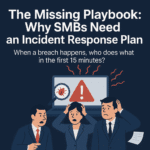In today's rapidly evolving digital landscape, cyber threats are more sophisticated, frequent, and damaging than ever before. Businesses face everything from ransomware attacks and phishing schemes to insider threats and supply chain compromises. With the stakes higher than ever, choosing the right cybersecurity solution has become a critical business decision.
Adding to the complexity is the sheer volume of acronyms thrown into the mix—MDR, EDR, MSSP, XDR, SIEM, SOC. Each promises to protect your organization, but understanding the distinctions between these solutions and how they fit into your cybersecurity strategy can feel overwhelming.
This guide is here to decode the jargon, clarify the differences, and help you determine the best cybersecurity approach for your unique needs. Whether you're seeking endpoint protection, proactive threat response, or comprehensive security management, this article will break down the strengths, limitations, and ideal use cases for each solution.
By the end, you'll have the clarity and confidence to choose the cybersecurity solution that empowers your business to stay ahead of modern threats.
What Is MDR (Managed Detection and Response)?
Managed Detection and Response (MDR) is a fully managed cybersecurity service that combines cutting-edge technology with expert human intervention to detect, investigate, and respond to threats across your IT environment. Unlike traditional security solutions that rely solely on automation, MDR provides 24/7 monitoring and proactive threat hunting to stop cyberattacks before they escalate.
Core Features of MDR
- Proactive Threat Detection: Uses advanced tools like behavioral analytics, machine learning, and threat intelligence to identify suspicious activities and potential threats.
- Human-Led Incident Response: Expert analysts investigate and neutralize threats in real time, ensuring swift and accurate responses.
- 24/7 Monitoring: Round-the-clock vigilance to prevent gaps in your security coverage, even during off-hours or holidays.
- Seamless Integration: MDR often incorporates advanced security tools like Endpoint Detection and Response (EDR), Security Orchestration, Automation, and Response (SOAR), and other technologies for holistic protection.
Benefits of MDR
- Rapid Threat Response: Minimizes the time to detect and respond to incidents, reducing potential damage.
- Scalability: Adapts to the size and needs of your organization, whether you're a startup or a mid-sized business.
- Cost Efficiency: Provides enterprise-grade security without the need to invest in expensive tools, infrastructure, or full-time security personnel.
- Expertise on Demand: Gives you access to experienced security professionals who can manage complex incidents and reduce false positives.
When Should You Consider MDR?
MDR is an excellent choice for organizations that:
- Lack a dedicated internal Security Operations Center (SOC) or security team.
- Face challenges in managing the volume of alerts generated by their current tools.
- Need a proactive, managed solution to reduce risks without adding operational complexity.
What Is EDR (Endpoint Detection and Response)?
Endpoint Detection and Response (EDR) is a cybersecurity solution specifically designed to monitor, detect, and respond to threats targeting endpoint devices such as laptops, desktops, servers, and mobile devices. Unlike traditional antivirus software, EDR provides advanced capabilities for threat detection and incident response at the device level.
Core Features of EDR
- Automated Threat Detection: Uses machine learning and behavioral analysis to identify malicious activities, such as unauthorized access or abnormal file behavior.
- Remediation Capabilities: Isolates affected devices, removes malicious files, and restores compromised systems to a safe state.
- Endpoint-Level Visibility: Provides deep insights into activity across individual devices, helping organizations trace the origin and scope of attacks.
- Threat Hunting: Enables security analysts to actively search for potential threats that automated systems might not detect.
Benefits of EDR
- Comprehensive Endpoint Protection: Guards against malware, ransomware, phishing, and insider threats.
- Rapid Incident Response: Automates the isolation and remediation of threats to prevent lateral movement within your network.
- Support for Remote Work: Secures endpoints that operate outside traditional corporate networks, a crucial capability for today's hybrid workforce.
- Cost-Effective: Offers a focused solution for organizations prioritizing endpoint security.
Limitations of EDR
While EDR is a powerful tool, it requires skilled security teams to interpret alerts, manage configurations, and take necessary action. Without dedicated personnel, organizations risk leaving threats unresolved or mismanaging false positives.
What Is XDR (Extended Detection and Response)?
Extended Detection and Response (XDR) is an advanced cybersecurity solution that provides unified threat detection and response across multiple domains, including endpoints, networks, servers, and cloud environments. Unlike standalone solutions like EDR, which focus on a single layer of security, XDR integrates data from various sources to deliver a more comprehensive view of threats and vulnerabilities.
Core Features of XDR
- Cross-Layered Visibility: Aggregates and correlates data across endpoints, networks, emails, cloud workloads, and more.
- Automated Threat Detection: Uses advanced analytics and machine learning to detect threats across your entire IT environment.
- Centralized Platform: Provides a unified dashboard for monitoring, investigation, and response, reducing complexity.
- Enhanced Response: Automates responses like isolating infected endpoints, blocking malicious network traffic, and more.
Benefits of XDR
- Comprehensive Protection: Covers multiple attack surfaces, making it ideal for businesses with diverse IT environments.
- Efficiency: Centralized data analysis reduces alert fatigue and simplifies incident investigation.
- Faster Response: Automates many response actions, reducing the workload on security teams.
- Cost-Effective: Replaces the need for managing multiple standalone tools by integrating them into one platform.
What Is SIEM (Security Information and Event Management)?
Security Information and Event Management (SIEM) is a technology solution designed to collect, aggregate, and analyze security logs and events from across your IT environment. It provides visibility into potential threats and generates alerts based on predefined rules or behavioral patterns.
Core Features of SIEM
- Data Aggregation: Collects logs and events from various systems, such as firewalls, endpoints, servers, and cloud platforms.
- Log Correlation and Analysis: Identifies patterns and anomalies by analyzing relationships between events.
- Alerting: Generates security alerts when it detects suspicious activity or rule violations.
- Compliance Reporting: Simplifies audits and reporting for regulatory requirements like PCI-DSS, HIPAA, and GDPR.
Limitations of SIEM
- Complexity: Requires significant expertise to configure and maintain effectively.
- Alert Fatigue: Generates high volumes of alerts, often including false positives.
- Reactive: Provides visibility but doesn't include proactive threat hunting or automated response.
What Is MSSP (Managed Security Service Provider)?
A Managed Security Service Provider (MSSP) is a service that helps businesses manage and monitor their cybersecurity tools, such as firewalls, SIEM platforms, and intrusion detection systems. MSSPs provide centralized security oversight, alerting businesses to potential threats and, in some cases, taking basic response actions like isolating affected systems or blocking malicious traffic.
Key Features and Benefits
- Comprehensive Security Management: Monitors and maintains key cybersecurity tools, including SIEM, firewalls, and IDS/IPS systems.
- Threat Monitoring and Escalation: Analyzes logs and identifies potential threats, escalating critical incidents to internal teams while addressing routine issues.
- Compliance Support: Simplifies audits and reporting to help businesses meet regulations like PCI-DSS, HIPAA, or GDPR.
- Scalable Services: Adapts to the size and needs of the organization, offering cost-effective security coverage.
Limitations of MSSP
- Limited Response Capabilities: MSSPs often handle low-level response actions (e.g., blocking malicious IPs) but rely on internal teams or third-party services for more advanced remediation.
- Reactive Approach: Focuses on alerting and escalation rather than proactive threat hunting or continuous monitoring of emerging risks.
What Is a SOC (Security Operations Center)?
A Security Operations Center (SOC) is a centralized team of cybersecurity professionals responsible for monitoring, detecting, and responding to threats across an organization's IT environment. The SOC operates as the hub of an organization's cybersecurity efforts, leveraging a combination of tools, processes, and expertise to ensure the business stays protected around the clock.
Core Functions of a SOC
- Threat Monitoring: Continuously monitors networks, endpoints, cloud environments, and other IT assets for suspicious activity.
- Incident Detection and Analysis: Identifies potential security incidents using tools like SIEM and analyzes them to determine their severity.
- Incident Response: Takes actions to mitigate, contain, and remediate threats, ensuring minimal disruption to operations.
- Threat Intelligence Integration: Incorporates global threat intelligence to stay ahead of emerging threats and tactics.
- Vulnerability Management: Identifies and addresses security gaps in systems, applications, and infrastructure.
Challenges of Building an In-House SOC
- High Costs: Staffing a SOC requires hiring skilled cybersecurity professionals, a significant investment in tools like SIEM and SOAR, and ongoing training.
- Resource-Intensive: Maintaining 24/7 operations demands a large team with rotating shifts, creating operational complexity.
- Alert Fatigue: Managing high volumes of alerts from tools like SIEM can overwhelm analysts, leading to missed threats or delays in response.
- Talent Shortages: The global shortage of cybersecurity professionals makes it difficult to hire and retain skilled SOC analysts.
Comparison of SOC, MDR, MSSP, EDR, and XDR
| Feature | SOC | MDR | MSSP | EDR | XDR |
|---|---|---|---|---|---|
| Type | In-house or outsourced service | Managed service | Managed service | Product | Product |
| Focus | Centralized threat monitoring & response | Proactive threat detection & response | Security operations management | Endpoint threat detection & response | Cross-layered threat detection & response |
| Response Capability | Internal or outsourced response | 24/7 human-led incident response | Limited (alert escalation) | Automated endpoint-level remediation | Automated with some human augmentation |
| Threat Hunting | Possible (internal or outsourced) | Yes (proactive and continuous) | No | Limited to endpoint analysis | Yes (cross-layered and proactive) |
| Monitoring Scope | Entire IT environment | Entire IT environment | Tools and log data | Endpoints only | Endpoints, networks, cloud, workloads |
| Ideal Use Case | Large organizations with resources | SMBs or organizations lacking internal expertise | Compliance-driven businesses needing monitoring | Organizations with skilled IT/security teams | Organizations seeking unified visibility |
| Cost | High (infrastructure, tools, staffing) | Moderate (managed service fees) | Moderate to low | Low to moderate | Moderate |
How to Choose the Right Cybersecurity Solution
Selecting the right cybersecurity solution depends on your organization's unique needs, resources, and risk profile. Here are key factors to consider:
Business Size and Resources
- Small to Mid-Sized Businesses (SMBs): Limited budgets and small IT teams make solutions like MDR or MSSP attractive, as they provide managed services without requiring significant in-house investment.
- Larger Enterprises: With more resources, enterprises can consider building an in-house SOC for full control or adopting XDR for advanced, unified protection.
Security Expertise
- Limited In-House Expertise: MDR is the best fit, as it combines cutting-edge tools with human expertise to detect, analyze, and respond to threats.
- Experienced IT Teams: Solutions like EDR or XDR can complement existing expertise, providing technology that internal teams can manage.
Regulatory and Compliance Needs
- Heavily Regulated Industries: MSSPs are well-suited for managing compliance requirements like PCI-DSS, HIPAA, or GDPR.
- Incident Response Requirements: MDR provides proactive threat hunting and response, which helps meet stringent regulatory expectations for incident management.
Conclusion
In today's rapidly evolving cybersecurity landscape, businesses face a critical decision: selecting the right solution to protect their operations, data, and reputation. Whether you're considering SOC, MDR, MSSP, EDR, or XDR, each option brings unique strengths tailored to specific security needs and challenges.
The right choice depends on your business's size, existing security posture, compliance needs, and threat landscape. Smaller organizations or those with limited in-house expertise often benefit from the managed services of MDR, while larger enterprises with extensive resources might opt for a combination of XDR and an in-house SOC.
No matter your starting point, the ultimate goal is the same: to strengthen your defenses, minimize risks, and ensure your business can operate securely in a world of ever-evolving cyber threats.
Ready to strengthen your defenses? Contact us to discover how our expertise can help protect your organization, streamline your security operations, and ensure peace of mind.



